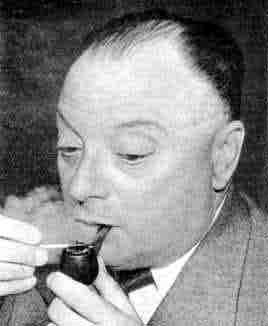Allgemeines
Biochemie
online
K. Förstner - webmaster@biochemieonline.de
Grundlagen
|
Biochemie und Chemie im Alltag
|
http://www.biochemieonline.de/
 Grundlagen
der Biochemie Grundlagen
der Biochemie
W. LOCKAU, Vorlesungsmitschrift von Till Biskup
Ein ausführlicher Überblick über die Grundlagen der
Biochemie.
http://amor.rz.hu-berlin.de/~h0444x2w/studium/gs/skripten/biochemie/biochemie.pdf
Biochemie.de
Roger Ritter - webmaster@biochemie.de
Biochemie.de ist eine zentrale Informationsplattform für
Naturwissenschaften
Databases
Gene,
Protein,
... |
Journals
Biochemistry,
Biotechnology,
Medicine,
Publishers,
... |
Societies
Academic,
Industrial,
Medical,
... |
Universities
Asia,
Australia,
Europe,
North
America, South
America, ... |
Companies
Biotechnology,
Chemicals,
Equipment,
Pharmaceuticals,
Services,
Supplies,
... |
Methods
General,
German,
... |
http://www.biochemie.de/
|
Biochemical
Pathways
This page gives access to the digitized version of the Boehringer
Mannheim "Biochemical Pathways" wall chart.
Please
enter one or more keyword(s) or partial word(s). For
example, you may type Oxoacyl. You will then
be given a list of all matching entries of the
"Biochemical Pathways" wall chart. If you
enter more than one keyword, only the entries
matching all keywords will be listed. |
| You
can also access the individual images by clicking in
a reduced image of an entire section of the wall
chart.
http://www.expasy.ch/cgi-bin/search-biochem-index
|
|
Experimentelle
Techniken der Biochemie und Immunologie
Arnulf Josef Hartl - arnulf.hartl@sbg.ac.at
- Generelle
Aspekte des Arbeitens mit biologischen Molekülen
Probenvorbereitung und Aufschlußtechniken
- Fällungen,
Dialyse, Ultrafiltration und Lyophilisierung
Abtrennung von Salzen und hydrophilen
Verunreinigungen, Detergenzien und ihre
Entfernung
- Chromatographieverfahren
(LC, HPLC, DC, FPLC)
Siebchromatographie,
Ionenaustauschchromatographie, Affinitäts- und
Immunaffinitätschromatographie
- Elektrophorese
SDS- und native PAGE, IEF und NEPHGE, 2D
Gelelektrophorese
- Immunchemie
Gewinnung von Antiseren, Genetische
Immunisierung, Monoklonale Antikörper,
Western-Blotting, ELISA, Cross-Western
- Das
Internet als Informationsquelle für Biologen
|
http://www.natur.sbg.ac.at/arnulf/exptech/exptech.htm
Metabolic
Pathways of Biochemistry
Karl J. Miller - mpb@www.gwu.edu
The following reaction pathways represent those which are
currently complete and those which are still under
construction.
http://www.gwu.edu/~mpb/
 Oxidative
Phosphorylierung Oxidative
Phosphorylierung
P. Schling
Ausführliches Online-Skript im PDF-Format (5,07 MB).
http://www.biologie.uni-regensburg.de/Biochemie/Loeffler/PDF/OxPhosSem2001a.pdf
Photosynthesis
hyperbio@mit.edu
http://esg-www.mit.edu:8001/esgbio/ps/psdir.html
An
Introduction to Photosynthesis and Its Applications
Wim Vermaas - wim@asu.edu
Sunlight plays a much larger role in our sustenance than we
may expect: all the food we eat and all the fossil fuel we
use is a product of photosynthesis, which is the process
that converts energy in sunlight to chemical forms of energy
that can be used by biological systems. Photosynthesis is
carried out by many different organisms, ranging from plants
to bacteria (Figure 1). The best known form of
photosynthesis is the one carried out by higher plants and
algae, as well as by cyanobacteria and their relatives,
which are responsible for a major part of photosynthesis in
oceans. All these organisms convert CO2 (carbon
dioxide) to organic material by reducing this gas to
carbohydrates in a rather complex set of reactions.
Electrons for this reduction reaction ultimately come from
water, which is then converted to oxygen and protons. Energy
for this process is provided by light, which is absorbed by
pigments (primarily chlorophylls and carotenoids).
Chlorophylls absorb blue and red light and carotenoids
absorb blue-green light (Figure 2), but green and yellow
light are not effectively absorbed by photosynthetic
pigments in plants; therefore, light of these colors is
either reflected by leaves or passes through the leaves.
This is why plants are green...
http://photoscience.la.asu.edu/photosyn/education/photointro.html
ASU
Photosynthesis Center
photosyn@asuchm.la.asu.edu
The ASU Center for the Study of Early Events in
Photosynthesis was established in 1988 as part of a joint
grant program of the Department of Energy, the National
Science Foundation, and the Department of Agriculture. The
Center consists of about 90 students, postdoctoral
associates and research scientists led by twelve faculty
members in the Department of Chemistry and Biochemistry and
the Department of Plant Biology. These research groups share
a common goal: understanding the process of photosynthesis,
which is responsible for producing all of our food and
filling the vast majority of our energy and fiber needs. The
impetus for development of the Center was the premise that
photosynthesis is a complex problem that will only yield to
an investigation using a wide variety of approaches and
techniques. Thus, the Photosynthesis Center serves as an
infrastructure supporting individual ASU scientists and
fostering multidisciplinary cooperative research projects.
http://photoscience.la.asu.edu/photosyn/
Milchsäuregärung
und Alkoholische Gärung
Ein knappes, aber informatives Online-Skript mit weiteren
Links.
http://www.egbeck.de/skripten/12/bs12-21.htm
Chemistry
of Drugs and the Brain
jjustice@emory.edu
Ein umfangreiches Lernprogramm mit Animationen (engl.)
http://www.emory.edu/CHEMISTRY/justice/chem190j/
|




